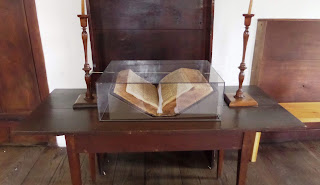 |
| The Ephrata Cloister |
The small borough of Ephrata located in northern Lancaster County is home to one of America's earliest religious communities known as the Ephrata Cloister.
This carefully preserved gem, founded in 1732 by German settlers led by a man by the name of Conrad Beissel, tells a tale of Pennsylvania's role in the quest for freedom of religion.
Beissel, who was born in Eberbach, Germany, took issue with his country's state-run churches, believing, instead, that citizens should be free to worship as they pleased. When he set sail for North America, he decided to settle in the only colony at the time to offer freedom of religion. By choosing Pennsylvania, Beissel had shaken the shackles of his native country's demands for obeisance to the religion of the rulers.
After arriving in the colonies, Beissel initially settled in Germantown before moving to Lancaster County, where he led a Brethren congregation. His quest for inner peace and his desire to escape the distractions of the world eventually led him to Ephrata to create a religious retreat.
Soon others were joining the charismatic Beissel and by 1750 approximately 80 men and women comprised the "Community of the Solitary" at Ephrata. All agreed to live a regimented, celibate life to better worship God.
Today the Ephrata Cloister is recognized as a National Historic Landmark, run by the Pennsylvania Historical and Museum Commission. Tours are conducted seven days a week until December and several days a week thereafter.
Taking the Tour
Parking is plentiful at the Cloister and a short walk takes guests to a Visitor's Center where they will be greeted by a guide in a simple, long, hooded, white robe, the traditional garb that residents were required to wear at the time.
After viewing a short film on Beissel and his pursuit of religious freedom, visitors are led to outside benches. There, in the midst of historic buildings that have been described as some of the most significant, surviving examples of pre-colonial architecture in America, guests learn more about the unique community.
 |
| Guide gives insight into the community that lived onsite. |
 |
| Bed with wooden block pillow. |
 |
| Bible in the Meeting House |
 |
| The Meetinghouse Dining area Spinning Area Squirrel Tail oven |
 |
| Guest cottage |
At the end of the tour, guests are given the opportunity to explore the grounds and outbuildings, sometimes with the help of modern technology. Guests can dial phone numbers listed on buildings to learn more about each structure.
Within the Cloister is also a cemetery, where visitors can see the headstones of those who have been laid to rest, including leader Conrad Beissel, whose passing in 1768 led to the slow demise of the community, after the takeover by Peter Miller, who believe that the monastic life was no longer attractive to new generations.
 |
| The Cemetery |
By 1777, a third of the members died of typhoid and by 1814, the Community of the Solitary at Ephrata dissolved as the last four followers joined the Seventh Day Baptist Church, marking an end to the "holy experiment."
To learn more, visit: www.ephratacloster.org.



